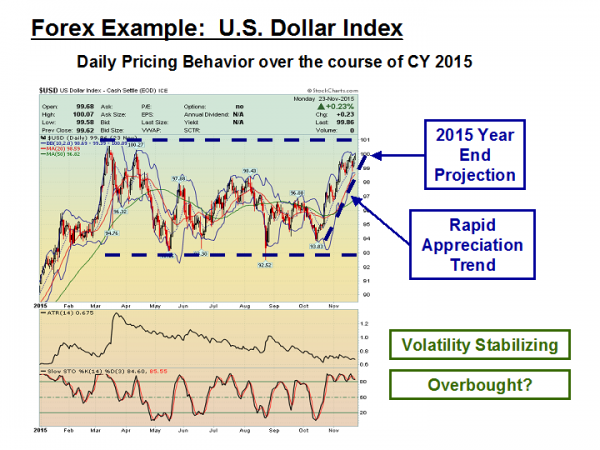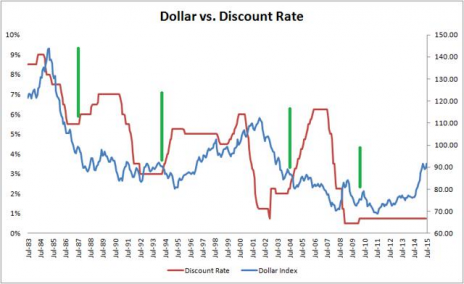Everyone loves to find a sure thing, especially in today’s financial markets. If you were to pay avid attention to the host of pro-dollar articles that are beginning to appear in the press, then you would be quickly going long in every USD pairing that you could find. The “herd” of forex pundits has formed and is heading in one direction. Will the dollar bulls get the message and force the Bears into their hibernation caves for months to come? Or, as is usually the case, will the herd be on the wrong side of the equation?
The days are falling to the wayside before the oncoming December “Judgment Day,” that is, according to Fed Watch aficionados, the day the Fed finally hikes interest rates by a whopping 25 basis points. Grade-school logic dictates that a rise in rates will create more demand for USD-based securities, and, consequently, the mighty greenback will pound away on its rivals until they scream “Uncle Sam.” Some of you may remember that with each passing year in school, we would learn that the previous year’s learning was not exactly the final word on things. We then learned to fear “exceptions to the rule.”
Whether the U.S. dollar is on the verge of a breakout is still up for debate. At the outset of this final quarter of the year, the USD index was languishing around 94, but banking analysts were already committing to a forecast of 100 by yearend. Coincidentally, as if on cue, King dollar has rallied over the past several weeks, ascending to the aforesaid 100 level, empirical evidence that the world has factored in the 25bp increase that everyone and their grandmother is expecting. In situations such as these, the USD might very well drop in value upon the news, the dreaded exception to the rule.
There is no doubt that the dollar has been on a strengthening tear since May of 2014. The catchphrase for that period of time and forward has been “divergence in central banking policy,” the fundamental factor that has been driving global revaluations. The dramatic run up of the greenback eclipsed 100 on the index back in March, never to return again, until now. After months of hovering in the nineties, the Almighty dollar is just a hair’s breath away from breaking above what has been termed heavy resistance. The obvious question is the one often asked at this time, “What’s next?”
Is there more to be gleaned from recent pricing behavior charts?
The chart below summarizes the price action for the USD index for 2015. From its peak in March, the dollar shifted into the typical ranging behavior that would precede any actions anticipated by the Fed. The recent run up has been severe. The Stochastic indicator is pounding the overbought drum loud and clear. Volatility has leveled off to a degree, a supposed calm before the storm. The Fed’s meeting in December is still weeks away. One would almost expect a small dip in the near term while we wait.

The lower boundary of the range is actually the 38.2% Fibonacci line for the recent eleven-month appreciation trend. This support level has been tested on several occasions, and, despite the obvious “Head & Shoulders” pattern, the dollar rebounded heavily to the north. One thing to remember is that 80% of the index is weighted by what happens to the euro, the yen, and the Canadian dollar, each of which has been in decline of late. The question is whether the dollar has any steam left in its engines to mount another charge and pierce through the substantial resistance at the 101 level.
What are the arguments that support more appreciation?
The last time the USD index was above the formidable resistance line in the above chart was back around the Millennium crossover. If you go back three decades, the index was at 120 in the late eighties. It has been in a long-term, gradual decline from that point in time, evidence of the growing trade imbalances in the U.S. over the period and the need to expand the money supply to cover global obligations. Coincidentally enough, the present valuation also sits just below a diagonal resistance line drawn from 1987 forward. Yes, the resistance is formidable, but there are several arguments that support more appreciation of the greenback in the near-term future. Here are a few of them:
- The Fed is the only major central bank contemplating a near-term interest rate increase. The Bank of England has backed away from tagging along. UK financial officials do not see the possibility of a rate hike before the second quarter of 2016;
- Fed governors have recently been on the speaking trail, pumping up their chests and priming the market for action in December. It is difficult to believe that these same governors would risk losing face a second time, another reason for the severity of the recent appreciation run;
- The belief now is that more rate increases will follow, in line with the gradually rising rate scenario that the Fed has telegraphed to analysts for the past year. A review of past rate hikes also reveals that multiple hikes are coming. The Fed has never pursued a “one-and-done” strategy;
- The euro and yen, over 70% of the index, are both stomping down the quantitative easing road. The economies in Europe and Japan show glimmers of hope, but not enough to cause their respective central banks to curtail current asset buy-back programs or to reconsider reducing interest rates in the near term. The loonie may, however, get a lift in 2016 when oil prices recover lost ground, an opinion shared by the majority of industry analysts;
- Lastly, inflation may be hovering below the 2% target, but the Fed does not want to get caught flatfooted when oil prices bounce back. The most amazing characteristic of the recovery has been the lack of rapidly increasing inflation rates, something that everyone predicted in 2008 when money presses went into high gear. It has not happened. In fact, deflation has gripped many parts of the world for years on end. If and when there is a major pick up in global economic activity, inflation could become the new focus of attention.
What are the arguments that support a falling dollar in the year ahead?
Not everyone is on board the appreciation train. There are valid arguments to the contrary, as there always are when uncertainty is about. As much as we would like to believe that a sure thing might exist, financial markets have a way of ignoring herd mentality, reversing direction, and destroying the best trading strategies on the planet. Before you run out and short every major USD pairing, you might want to consider the following arguments:
- The first point is the obvious one – 101 represents formidable resistance on both a short and long-term basis. A rise is predicated on the Fed raising rates in December, but the futures markets have only baked in a 70% probability for this timing of a rate hike;
- Global economic growth continues to wane. The IMF has already noted that global GDP growth rates are at their lowest level since the 2008 crisis. They also keep revising their annual forecasts downward, with no apparent end in sight;
- The deflation spiral in global commodity markets is scary. Over supply in many areas suggests that there is a great deal of slack to burn through before normal supply and demand dynamics can resume. A stronger dollar only exacerbates the problem, since commodity contracts are traditionally priced in USD denominated lots. The IMF has also singled out commodities for the primary reason for economic sluggishness in China, which has had a deleterious impact on other emerging market economies;
- The United States is not an island. Our economy may be leading the way at the moment, but, if the rest of the world does not follow, then our multinational corporations will soon feel the heat. Demand for our products will take a nosedive. Earnings will drop. The pain felt in other regions will come to our shores eventually;
- Lastly, raising rates will not fix everything over night. The Fed’s balance sheet is still bloated. Trade imbalances are expanding under the weight of a highly valued dollar. To the contrary, history demonstrates that the USD index actually declines some 12% over the two-year period following a rate increase. The reasons are multi-faceted, resulting in an economic slowdown.
In a previous article regarding the strength of the Almighty Dollar, we presented an award-winning chart that supported this last line of reasoning:

In the past three decades, there have been four occasions when the Fed reversed the tide of declining discount rates, as depicted by the green bars in the above chart. Will even a small rise in rates produce the same “contrarian” result as in the past? One analyst’s interpretation of this implied correlation is that, “Increasing rates tends to slow the economy. As the economy slows, foreign funds exit for more active pastures putting bearish pressure on the dollar.” Heed history, or endure its consequences.
Concluding Remarks
The Fed meeting in December is scheduled for the 15 and 16th of the month. As per the prevailing opinion on the street, “Surveys show that around 92% of primary dealers and economists expect the Fed to raise interest rates in the middle of December.” Between now and then, the November jobs report will have been history. After the stellar figure of 271,000 net additions in October, one would think that the bottom would only fall if November came in as a shocker, well below six figures. Only then would the Fed, perhaps, reconsider raising rates a few weeks later.
As for now, the “herd” has spoken. There may still be uncertainty as to whether this hike will be of the “one-and-done” variety, but the pack surely expects liftoff to occur in 2015. As for what happens next, it is anyone’s guess. History seems to suggest that a “sell-on-the-news” event is in the offing, followed by a further weakening of the greenback to ensure that our economic ship of state stays in safe waters. There may be a few bumps in the road, until everything is sorted out, another reason to expect more volatility in the months ahead. Timing will be everything, but you have heard that axiom before. In the meantime, let caution be your guide.
Risk Statement: Trading Foreign Exchange on margin carries a high level of risk and may not be suitable for all investors. The possibility exists that you could lose more than your initial deposit. The high degree of leverage can work against you as well as for you.